William Franklin Graham Jr. (November 7, 1918 – February 21, 2018) was an American evangelist, a prominent evangelical Christian figure, and an ordained Southern Baptist minister who became well-known internationally in the late 1940s. One of his biographers has placed him “among the most influential Christian leaders” of the 20th century.
About William Franklin Graham Jr.
 William Franklin Graham Jr. was born on November 7, 1918, in the downstairs bedroom of a farmhouse near Charlotte, North Carolina. He was of Scots-Irish descent and was the eldest of four children born to Morrow (née Coffey) and William Franklin Graham Sr., a dairy farmer. Graham was raised on a family dairy farm with his two younger sisters, Catherine Morrow and Jean and a younger brother, Melvin Thomas. When he was eight years old in 1927, the family moved about 75 yards (69 m) from their white frame house to a newly built red brick home.
William Franklin Graham Jr. was born on November 7, 1918, in the downstairs bedroom of a farmhouse near Charlotte, North Carolina. He was of Scots-Irish descent and was the eldest of four children born to Morrow (née Coffey) and William Franklin Graham Sr., a dairy farmer. Graham was raised on a family dairy farm with his two younger sisters, Catherine Morrow and Jean and a younger brother, Melvin Thomas. When he was eight years old in 1927, the family moved about 75 yards (69 m) from their white frame house to a newly built red brick home.
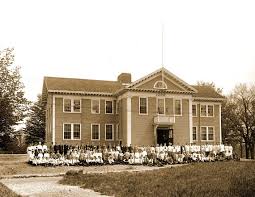 He was raised by his parents in the Associate Reformed Presbyterian Church. Graham attended the Sharon Grammar School. He started to read books from an early age and loved to read novels for boys, especially Tarzan. Like Tarzan, he would hang on the trees and gave the popular Tarzan yell, scaring both horses and drivers. According to his father, that yelling had led him to become a minister. Graham was 14 when Prohibition ended in December 1933, and his father forced him and his sister Katherine to drink beer until they became sick. This created such an aversion that Graham and his sister avoided alcohol and drugs for the rest of their lives.
He was raised by his parents in the Associate Reformed Presbyterian Church. Graham attended the Sharon Grammar School. He started to read books from an early age and loved to read novels for boys, especially Tarzan. Like Tarzan, he would hang on the trees and gave the popular Tarzan yell, scaring both horses and drivers. According to his father, that yelling had led him to become a minister. Graham was 14 when Prohibition ended in December 1933, and his father forced him and his sister Katherine to drink beer until they became sick. This created such an aversion that Graham and his sister avoided alcohol and drugs for the rest of their lives.
Graham had been turned down for membership in a local youth group for being “too worldly” when Albert McMakin, who worked on the Graham farm, persuaded him to go and see the evangelist Mordecai Ham. According to his autobiography, Graham was 16 in 1934 when he was converted during a series of revival meetings that Ham led in Charlotte.
 After graduating from Sharon High School in May 1936, Graham attended Bob Jones College. After one semester, he found that the coursework and rules were too legalistic . At this time he was influenced and inspired by Pastor Charley Young from Eastport Bible Church. He was almost expelled, but Bob Jones Sr. warned him not to throw his life away: “At best, all you could amount to would be a poor country Baptist preacher somewhere out in the sticks … You have a voice that pulls. God can use that voice of yours. He can use it mightily.”
After graduating from Sharon High School in May 1936, Graham attended Bob Jones College. After one semester, he found that the coursework and rules were too legalistic . At this time he was influenced and inspired by Pastor Charley Young from Eastport Bible Church. He was almost expelled, but Bob Jones Sr. warned him not to throw his life away: “At best, all you could amount to would be a poor country Baptist preacher somewhere out in the sticks … You have a voice that pulls. God can use that voice of yours. He can use it mightily.”
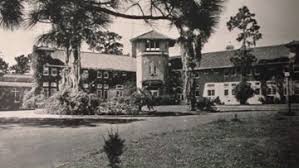 In 1937 Graham transferred to the Florida Bible Institute in Temple Terrace, Florida. He preached his first sermon that year at Bostwick Baptist Church near Palatka, Florida, while still a student. In his autobiography, Graham wrote of receiving his “calling on the 18th green of the Temple Terrace Golf and Country Club”, which was adjacent to the institute’s campus.
In 1937 Graham transferred to the Florida Bible Institute in Temple Terrace, Florida. He preached his first sermon that year at Bostwick Baptist Church near Palatka, Florida, while still a student. In his autobiography, Graham wrote of receiving his “calling on the 18th green of the Temple Terrace Golf and Country Club”, which was adjacent to the institute’s campus.
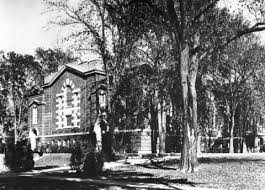 Reverend Billy Graham Memorial Park was later established on the Hillsborough River, directly east of the 18th green and across from where Graham often paddled a canoe to a small island in the river, where he would practice preaching to the birds, alligators, and cypress stumps. In 1939, Graham was ordained by a group of Southern Baptist clergy at Peniel Baptist Church in Palatka, Florida. In 1943, Graham graduated from Wheaton College in Wheaton, Illinois, with a degree in anthropology.
Reverend Billy Graham Memorial Park was later established on the Hillsborough River, directly east of the 18th green and across from where Graham often paddled a canoe to a small island in the river, where he would practice preaching to the birds, alligators, and cypress stumps. In 1939, Graham was ordained by a group of Southern Baptist clergy at Peniel Baptist Church in Palatka, Florida. In 1943, Graham graduated from Wheaton College in Wheaton, Illinois, with a degree in anthropology.
 During his time at Wheaton, Graham decided to accept the Bible as the infallible word of GOD. Henrietta Mears of the First Presbyterian Church of Hollywood in California was instrumental in helping Graham wrestle with the issue. He settled it at Forest Home Christian Camp (now called Forest Home Ministries) southeast of the Big Bear Lake area in southern California. A memorial there marks the site where Graham made his decision.
During his time at Wheaton, Graham decided to accept the Bible as the infallible word of GOD. Henrietta Mears of the First Presbyterian Church of Hollywood in California was instrumental in helping Graham wrestle with the issue. He settled it at Forest Home Christian Camp (now called Forest Home Ministries) southeast of the Big Bear Lake area in southern California. A memorial there marks the site where Graham made his decision.
Family life
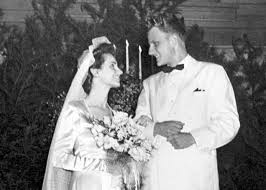 On August 13, 1943, Graham married Wheaton classmate Ruth Bell, whose parents were Presbyterian missionaries in China. Her father, L. Nelson Bell, was a general surgeon. Ruth died on June 14, 2007, at the age of 87. The couple were married for almost 64 years.
On August 13, 1943, Graham married Wheaton classmate Ruth Bell, whose parents were Presbyterian missionaries in China. Her father, L. Nelson Bell, was a general surgeon. Ruth died on June 14, 2007, at the age of 87. The couple were married for almost 64 years.
Graham and his wife had five children together: Virginia Leftwich (Gigi) Graham (b. 1945), an inspirational speaker and author; Anne Graham Lotz (b. 1948), runs AnGeL ministries; Ruth Graham (b. 1950), founder and president of Ruth Graham & Friends, leads conferences throughout the US and Canada; Franklin Graham (b. 1952), serves as president and CEO of the Billy Graham Evangelistic Association and as president and CEO of international relief 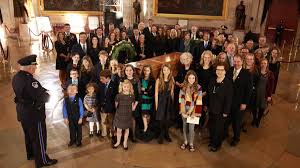 organization, Samaritan’s Purse; and Nelson Edman Graham (b. 1958), a pastor who runs East Gates Ministries International, which distributes Christian literature in China.
organization, Samaritan’s Purse; and Nelson Edman Graham (b. 1958), a pastor who runs East Gates Ministries International, which distributes Christian literature in China.
At the time of his death at age 99 in 2018, Graham was survived by 5 children, 19 grandchildren (including Will Graham and Tullian Tchividjian), 41 great-grandchildren and 6 great-great-grandchildren.
The Preacher
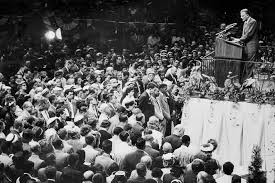 As a preacher, he held large indoor and outdoor rallies with sermons that were broadcast on radio and television; some were still being rebroadcast into the 21st century. In his six decades on television, Graham hosted annual “Crusades”, evangelistic campaigns that ran from 1947 until his retirement in 2005. He also hosted the radio show Hour of Decision from 1950 to 1954. He repudiated racial segregation and insisted on racial integration for his revivals and crusades, starting in 1953; he also invited Martin Luther King Jr. to preach jointly at a revival in New York City in 1957.
As a preacher, he held large indoor and outdoor rallies with sermons that were broadcast on radio and television; some were still being rebroadcast into the 21st century. In his six decades on television, Graham hosted annual “Crusades”, evangelistic campaigns that ran from 1947 until his retirement in 2005. He also hosted the radio show Hour of Decision from 1950 to 1954. He repudiated racial segregation and insisted on racial integration for his revivals and crusades, starting in 1953; he also invited Martin Luther King Jr. to preach jointly at a revival in New York City in 1957.
 In addition to his religious aims, he helped shape the worldview of a huge number of people who came from different backgrounds, leading them to find a relationship between the Bible and contemporary secular viewpoints. According to his website, Graham preached to live audiences of 210 million people in more than 185 countries and territories through various meetings, including BMS World Mission and Global Mission.
In addition to his religious aims, he helped shape the worldview of a huge number of people who came from different backgrounds, leading them to find a relationship between the Bible and contemporary secular viewpoints. According to his website, Graham preached to live audiences of 210 million people in more than 185 countries and territories through various meetings, including BMS World Mission and Global Mission.
Career in Ministry
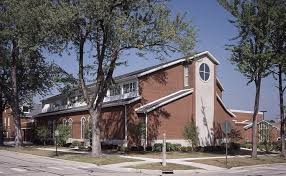 While attending college, Graham became pastor of the United Gospel Tabernacle and also had other preaching engagements.
While attending college, Graham became pastor of the United Gospel Tabernacle and also had other preaching engagements.
From 1943 to 1944, Graham briefly served as pastor of the First Baptist Church in Western Springs, Illinois, which was not far from Wheaton. While there, his friend Torrey Johnson, pastor of the Midwest Bible Church in Chicago, told Graham that his radio program, Songs in the Night, was about to be canceled due to lack of funding.
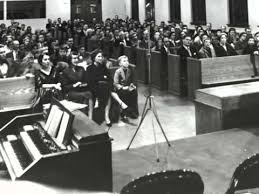 Consulting with the members of his church in Western Springs, Graham decided to take over Johnson’s program with financial support from his congregation. Launching the new radio program on January 2, 1944, still called Songs in the Night, Graham recruited the bass-baritone George Beverly Shea as his director of radio ministry. While the radio ministry continued for many years, Graham decided to move on in early 1945.
Consulting with the members of his church in Western Springs, Graham decided to take over Johnson’s program with financial support from his congregation. Launching the new radio program on January 2, 1944, still called Songs in the Night, Graham recruited the bass-baritone George Beverly Shea as his director of radio ministry. While the radio ministry continued for many years, Graham decided to move on in early 1945.
 Graham was 29 in 1948 when he became president of Northwestern Bible College in Minneapolis; he was the youngest president of a college or university in the country and held the position for four years before he resigned in 1952. Graham initially intended to become a chaplain in the Armed Forces, but he contracted mumps shortly after applying for a commission.
Graham was 29 in 1948 when he became president of Northwestern Bible College in Minneapolis; he was the youngest president of a college or university in the country and held the position for four years before he resigned in 1952. Graham initially intended to become a chaplain in the Armed Forces, but he contracted mumps shortly after applying for a commission.
After a period of recuperation in Florida, he was hired as the first full-time evangelist of the new Youth for Christ (YFC), 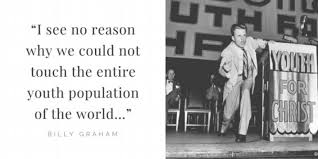 co-founded by Torrey Johnson and the Canadian evangelist Charles Templeton. Graham traveled throughout both the United States and Europe as a YFCI evangelist. Templeton applied to Princeton Theological Seminary for an advanced theological degree and urged Graham to do so as well, but he declined as he was already serving as the president of Northwestern Bible College.
co-founded by Torrey Johnson and the Canadian evangelist Charles Templeton. Graham traveled throughout both the United States and Europe as a YFCI evangelist. Templeton applied to Princeton Theological Seminary for an advanced theological degree and urged Graham to do so as well, but he declined as he was already serving as the president of Northwestern Bible College.
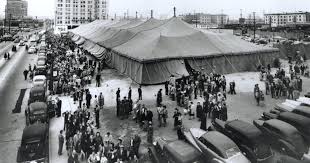 Graham scheduled a series of revival meetings in Los Angeles in 1949, for which he erected circus tents in a parking lot. He attracted national media coverage, especially in the conservative Hearst chain, although Hearst and Graham never met. The crusade event ran for eight weeks – five weeks longer than planned. Graham became a national figure with heavy coverage from the wire services and national magazines.
Graham scheduled a series of revival meetings in Los Angeles in 1949, for which he erected circus tents in a parking lot. He attracted national media coverage, especially in the conservative Hearst chain, although Hearst and Graham never met. The crusade event ran for eight weeks – five weeks longer than planned. Graham became a national figure with heavy coverage from the wire services and national magazines.
Billy Graham Crusades
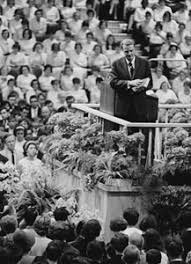 From the time his ministry began in 1947, Graham conducted more than 400 crusades in 185 countries and territories on six continents. The first Billy Graham Crusade, held September 13–21, 1947, in the Civic Auditorium in Grand Rapids, Michigan, was attended by 6,000 people. Graham was 28 years old. He called them crusades, after the medieval Christian forces who conquered Jerusalem. He would rent a large venue, such as a stadium, park, or street. As the sessions became larger, he arranged a group of up to 5,000 people to sing in a choir. He would preach the gospel and invite people to come forward (a practice begun by Dwight L. Moody).
From the time his ministry began in 1947, Graham conducted more than 400 crusades in 185 countries and territories on six continents. The first Billy Graham Crusade, held September 13–21, 1947, in the Civic Auditorium in Grand Rapids, Michigan, was attended by 6,000 people. Graham was 28 years old. He called them crusades, after the medieval Christian forces who conquered Jerusalem. He would rent a large venue, such as a stadium, park, or street. As the sessions became larger, he arranged a group of up to 5,000 people to sing in a choir. He would preach the gospel and invite people to come forward (a practice begun by Dwight L. Moody).
Such people were called inquirers and were given the chance to speak one-on-one with a counselor, to clarify questions and pray together. 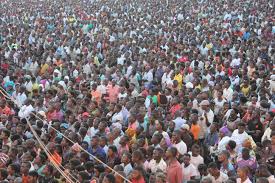 The inquirers were often given a copy of the Gospel of John or a Bible study booklet. In Durban, South Africa, in 1973, the crowd of some 100,000 was the first large mixed-race event in apartheid South Africa. In Moscow, in 1992, one-quarter of the 155,000 people in Graham’s audience went forward at his call. During his crusades, he frequently used the altar call song, “Just As I Am”.
The inquirers were often given a copy of the Gospel of John or a Bible study booklet. In Durban, South Africa, in 1973, the crowd of some 100,000 was the first large mixed-race event in apartheid South Africa. In Moscow, in 1992, one-quarter of the 155,000 people in Graham’s audience went forward at his call. During his crusades, he frequently used the altar call song, “Just As I Am”.
Graham was offered a five-year, $1 million contract from NBC to appear on television opposite Arthur Godfrey, but he had pre arranged commitments. He turned down the offer in order to continue his touring revivals. Graham had crusades in London, which lasted 12 weeks, and a New York City crusade in Madison Square Garden in 1957, which ran nightly for 16 weeks.
Student Christian Fellowship
 Graham spoke at InterVarsity Christian Fellowship’s Urbana Student Missions Conference at least nine times – in 1948, 1957, 1961, 1964, 1976, 1979, 1981, 1984, and 1987.
Graham spoke at InterVarsity Christian Fellowship’s Urbana Student Missions Conference at least nine times – in 1948, 1957, 1961, 1964, 1976, 1979, 1981, 1984, and 1987.
At each Urbana conference, he challenged the thousands of attendees to make a commitment to follow Jesus Christ for the rest of their lives. He often quoted a six-word phrase that was reportedly written in the Bible of William Whiting Borden, the son of a wealthy silver magnate: “No reserves, no retreat, no regrets”. Borden had died in Egypt on his way to the mission field.
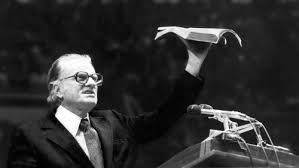 Graham also held evangelistic meetings on a number of college campuses: at the University of Minnesota during Inter Varsity’s “Year of Evangelism” in 1950–51, a 4-day mission at Yale University in 1957, and a week-long series of meetings at the University of North Carolina’s Carmichael Auditorium in September 1982.
Graham also held evangelistic meetings on a number of college campuses: at the University of Minnesota during Inter Varsity’s “Year of Evangelism” in 1950–51, a 4-day mission at Yale University in 1957, and a week-long series of meetings at the University of North Carolina’s Carmichael Auditorium in September 1982.
In 1955, he was invited by Cambridge University students to lead the mission at the school; the mission was arranged by the Cambridge Inter-Collegiate Christian Union, with London pastor-theologian John Stott serving as Graham’s chief assistant. This invitation was greeted with much disapproval in the correspondence columns of The Times.
Billy Graham Evangelistic Association
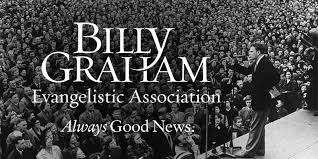 In 1950, Graham founded the Billy Graham Evangelistic Association (BGEA) with its headquarters in Minneapolis. The association relocated to Charlotte, North Carolina, in 1999, and maintains a number of international offices, such as in Hong Kong, Tokyo, and Buenos Aires. BGEA ministries have included:
In 1950, Graham founded the Billy Graham Evangelistic Association (BGEA) with its headquarters in Minneapolis. The association relocated to Charlotte, North Carolina, in 1999, and maintains a number of international offices, such as in Hong Kong, Tokyo, and Buenos Aires. BGEA ministries have included:
- Hour of Decision, a weekly radio program broadcast around the world for more than 50 years
- Mission television specials broadcast in almost every market in the US and Canada
- A syndicated newspaper column, My Answer, carried by newspapers across the United States and distributed by Tribune Content Agency
- Decision magazine, the official publication of the association
- Christianity Today was started in 1956 with Carl F. H. Henry as its first editor
- Passageway.org, the website for a youth discipleship program created by BGEA
- World Wide Pictures, which has produced and distributed more than 130 films
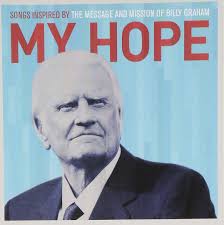 In April 2013, the Billy Graham Evangelistic Association started “My Hope With Billy Graham”, the largest outreach in its history, encouraging church members to spread the gospel in small group meetings after showing a video message by Graham. “The idea is for Christians to follow the example of the disciple Matthew in the New Testament and spread the gospel in their own homes.” The video, called “The Cross”, is the main program in the My Hope America series and was also broadcast the week of Graham’s 95th birthday.
In April 2013, the Billy Graham Evangelistic Association started “My Hope With Billy Graham”, the largest outreach in its history, encouraging church members to spread the gospel in small group meetings after showing a video message by Graham. “The idea is for Christians to follow the example of the disciple Matthew in the New Testament and spread the gospel in their own homes.” The video, called “The Cross”, is the main program in the My Hope America series and was also broadcast the week of Graham’s 95th birthday.
Billy Graham’s Civil rights movement
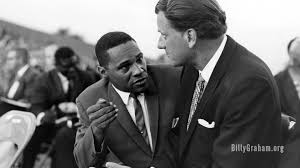 Graham’s early crusades were segregated, but he began adjusting his approach in the 50s. During a 1953 rally in Chattanooga, Tennessee, Graham tore down the ropes that organizers had erected in order to segregate the audience into racial sections. In his memoirs, he recounted that he told two ushers to leave the barriers down “or you can go on and have the revival without me.” He warned a white audience, “we have been proud and thought we were better than any other race, any other people. Ladies and gentlemen, we are going to stumble into hell because of our pride.”
Graham’s early crusades were segregated, but he began adjusting his approach in the 50s. During a 1953 rally in Chattanooga, Tennessee, Graham tore down the ropes that organizers had erected in order to segregate the audience into racial sections. In his memoirs, he recounted that he told two ushers to leave the barriers down “or you can go on and have the revival without me.” He warned a white audience, “we have been proud and thought we were better than any other race, any other people. Ladies and gentlemen, we are going to stumble into hell because of our pride.”
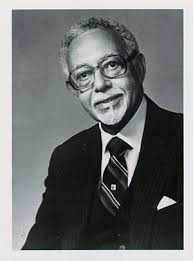 In 1957, Graham’s stance towards integration became more publicly shown when he allowed black ministers Thomas Kilgore and Gardner C. Taylor to serve as members of his New York Crusade’s executive committee and invited the Rev. Martin Luther King Jr., whom he first met during the Montgomery bus boycott in 1955, to join him in the pulpit at his 16-week revival in New York City, where 2.3 million gathered at Madison Square Garden, Yankee Stadium, and Times Square to hear them.
In 1957, Graham’s stance towards integration became more publicly shown when he allowed black ministers Thomas Kilgore and Gardner C. Taylor to serve as members of his New York Crusade’s executive committee and invited the Rev. Martin Luther King Jr., whom he first met during the Montgomery bus boycott in 1955, to join him in the pulpit at his 16-week revival in New York City, where 2.3 million gathered at Madison Square Garden, Yankee Stadium, and Times Square to hear them.
Graham recalled in his autobiography that during this time, he and King developed a close friendship and that he was eventually one of the few people who referred to King as “Mike”, a nickname which 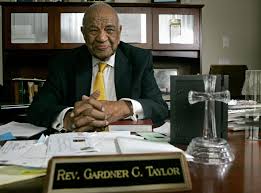 King asked only his closest friends to call him. Following King’s assassination in 1968, Graham mourned that the US had lost “a social leader and a prophet”. In private, Graham advised King and other members of the Southern Christian Leadership Conference (SCLC).
King asked only his closest friends to call him. Following King’s assassination in 1968, Graham mourned that the US had lost “a social leader and a prophet”. In private, Graham advised King and other members of the Southern Christian Leadership Conference (SCLC).
Despite their friendship, tensions between Graham and King emerged in 1958 when the sponsoring committee of a crusade which took place in San Antonio, Texas on July 25 arranged for Graham to be introduced by that state’s segregationist governor, Price Daniel.
On July 23, King sent a letter to Graham and informed him that allowing Daniel to speak at a crusade which occurred the night before the state’s Democratic Primary “can well be interpreted as your endorsement of racial segregation and discrimination.” Graham’s advisor, Grady Wilson, replied to King that “even though we do not see eye to eye with him on every issue, we still love him in Christ.”
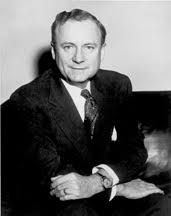 Though Graham’s appearance with Daniel dashed King’s hopes of holding joint crusades with Graham in the Deep South, the two still remained friends and King told a Canadian television audience the following year that Graham had taken a “very strong stance against segregation.” Graham and King would also come to differ on the Vietnam War. After King’s “Beyond Vietnam” speech denouncing US intervention in Vietnam, Graham castigated him and others for their criticism of US foreign policy.
Though Graham’s appearance with Daniel dashed King’s hopes of holding joint crusades with Graham in the Deep South, the two still remained friends and King told a Canadian television audience the following year that Graham had taken a “very strong stance against segregation.” Graham and King would also come to differ on the Vietnam War. After King’s “Beyond Vietnam” speech denouncing US intervention in Vietnam, Graham castigated him and others for their criticism of US foreign policy.
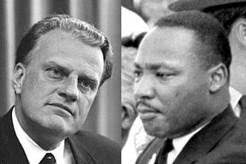 By the middle of 1960, King and Graham traveled together to the Tenth Baptist World Congress of the Baptist World Alliance. In 1963, Graham posted bail for King to be released from jail during the Birmingham campaign, according to Long (2008), and the King Center acknowledged that Graham had bailed King out of jail during the Albany Movement, although historian Steven Miller told CNN he could not find any proof of the incident. Graham held integrated crusades in Birmingham, Alabama, on Easter 1964 in the aftermath of the bombing of the Sixteenth Street Baptist Church, and toured Alabama again in the wake of the violence that accompanied the first Selma to Montgomery march in 1965.
By the middle of 1960, King and Graham traveled together to the Tenth Baptist World Congress of the Baptist World Alliance. In 1963, Graham posted bail for King to be released from jail during the Birmingham campaign, according to Long (2008), and the King Center acknowledged that Graham had bailed King out of jail during the Albany Movement, although historian Steven Miller told CNN he could not find any proof of the incident. Graham held integrated crusades in Birmingham, Alabama, on Easter 1964 in the aftermath of the bombing of the Sixteenth Street Baptist Church, and toured Alabama again in the wake of the violence that accompanied the first Selma to Montgomery march in 1965.
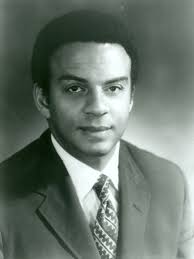 Following Graham’s death, former SCLC official and future Atlanta politician Andrew Young acknowledged his friendship with Graham and stated that Graham did in fact travel with King to the 1965 European Baptist Convention. Young also claimed that Graham had often invited King to his crusades in the Northern states.
Following Graham’s death, former SCLC official and future Atlanta politician Andrew Young acknowledged his friendship with Graham and stated that Graham did in fact travel with King to the 1965 European Baptist Convention. Young also claimed that Graham had often invited King to his crusades in the Northern states.
Graham’s faith prompted his maturing view of race and segregation; he told a member of the Ku Klux Klan that integration was necessary primarily for religious reasons: “There is no scriptural basis for segregation,” Graham argued. “The ground at the foot of the cross is level, and it touches my heart when I see whites standing shoulder to shoulder with blacks at the cross.
World evangelization
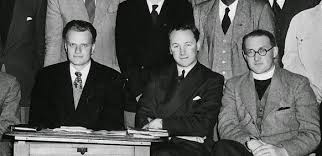 The friendship between Graham and John Stott led to a further partnership in the Lausanne Movement, of which Graham was a founder. It built on Graham’s 1966 World Congress on Evangelism in Berlin. In collaboration with Christianity Today, Graham convened what TIME magazine described as “a formidable forum, possibly the widest–ranging meeting of Christians ever held” with 2,700 participants from 150 nations gathering for the International Congress on World Evangelization.
The friendship between Graham and John Stott led to a further partnership in the Lausanne Movement, of which Graham was a founder. It built on Graham’s 1966 World Congress on Evangelism in Berlin. In collaboration with Christianity Today, Graham convened what TIME magazine described as “a formidable forum, possibly the widest–ranging meeting of Christians ever held” with 2,700 participants from 150 nations gathering for the International Congress on World Evangelization.
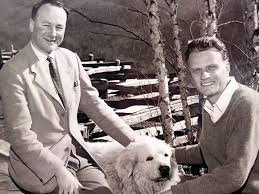 This took place in Lausanne, Switzerland (July 16–25, 1974), and the movement which ensued took its name from the host city. Its purpose was to strengthen the global church for world evangelization, and to engage ideological and sociological trends which bore on this. Graham invited Stott to be chief architect of the Lausanne Covenant, which issued from the Congress and which, according to Graham, “helped challenge and unite evangelical Christians in the great task of world evangelization.” The movement remains a significant fruit of Graham’s legacy, with a presence in nearly every nation.
This took place in Lausanne, Switzerland (July 16–25, 1974), and the movement which ensued took its name from the host city. Its purpose was to strengthen the global church for world evangelization, and to engage ideological and sociological trends which bore on this. Graham invited Stott to be chief architect of the Lausanne Covenant, which issued from the Congress and which, according to Graham, “helped challenge and unite evangelical Christians in the great task of world evangelization.” The movement remains a significant fruit of Graham’s legacy, with a presence in nearly every nation.
Reinforced multiple roles
 Graham played multiple roles that reinforced each other. Grant Wacker identified eight major roles that he played: preacher, icon, Southerner, entrepreneur, architect (bridge builder), pilgrim, pastor and finally his widely recognized status as America’s Protestant patriarch, which was on a par with Martin Luther King and Pope John Paul II.
Graham played multiple roles that reinforced each other. Grant Wacker identified eight major roles that he played: preacher, icon, Southerner, entrepreneur, architect (bridge builder), pilgrim, pastor and finally his widely recognized status as America’s Protestant patriarch, which was on a par with Martin Luther King and Pope John Paul II.
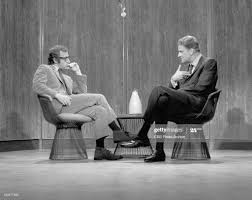 Graham deliberately reached into the secular world as a bridge builder. For example, as an entrepreneur he built his own pavilion for the 1964 New York World’s Fair. He appeared as a guest on a 1969 Woody Allen television special, where he joined the comedian in a witty exchange on theological matters.
Graham deliberately reached into the secular world as a bridge builder. For example, as an entrepreneur he built his own pavilion for the 1964 New York World’s Fair. He appeared as a guest on a 1969 Woody Allen television special, where he joined the comedian in a witty exchange on theological matters.
During the Cold War, Graham-the-bridge-builder became the first evangelist of note to speak behind the Iron Curtain, addressing large crowds in countries throughout Eastern Europe and in the Soviet Union, calling for peace. During the apartheid era, Graham consistently refused to visit South Africa until its government allowed integrated seating for audiences. During his first crusade there in 1973, he openly denounced apartheid. Graham also corresponded with imprisoned South African leader Nelson Mandela during the latter’s 27-year imprisonment.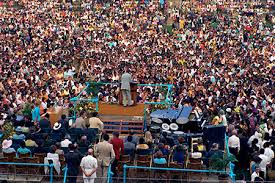
In 1984, he led a series of summer meetings—Mission England—in the United Kingdom, and he used outdoor football (soccer) fields for his venues.
Graham was interested in fostering evangelism around the world. In 1983, 1986 and 2000 he sponsored, organized and paid for massive training conferences for Christian evangelists; this was the largest representation of nations ever held until that time. Over 157 nations were gathered in 2000 at the RAI Convention Center in Amsterdam, the Netherlands. At one revival in Seoul, South Korea, Graham attracted more than one million people to a single service. He appeared in China in 1988 – for Ruth, this was a homecoming, since she had been born in China to missionary parents. He appeared in North Korea in 1992.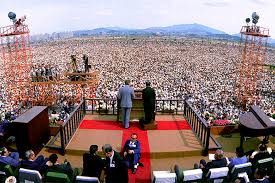
On October 15, 1989, Graham received a star on the Hollywood Walk of Fame. He was the only person functioning as a minister who received a star in that capacity.
On September 22, 1991, Graham held his largest event in North America on the Great Lawn of Manhattan’s Central Park. City officials estimated that more than 250,000 were in attendance. In 1998, Graham spoke to a crowd of scientists and philosophers at the Technology, Entertainment, Design Conference.
On September 14, 2001 (only three days after the World Trade Center attacks), Graham was invited to lead a service at Washington National Cathedral; the service was attended by President George W. Bush and past and present leaders. He also spoke at the memorial service following the Oklahoma City bombing in 1995.
On June 24–26, 2005, Graham began what he said would be his last North American crusade, three days at Flushing Meadows–Corona Park in the borough of Queens, New York City. On the weekend of March 11–12, 2006, Graham held the “Festival of Hope” with his son, Franklin Graham. The festival was held in New Orleans, which was recovering from Hurricane Katrina.
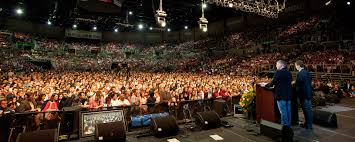 Graham prepared one last sermon, “My Hope America”, which was released on DVD and played around America and possibly worldwide between November 7–10, 2013. November 7 was Graham’s 95th birthday, and he hoped to cause a revival.
Graham prepared one last sermon, “My Hope America”, which was released on DVD and played around America and possibly worldwide between November 7–10, 2013. November 7 was Graham’s 95th birthday, and he hoped to cause a revival.
The Spiritual Adviser
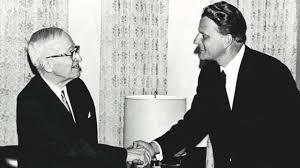 Graham was a spiritual adviser to U.S. presidents, and he provided spiritual counsel for every president from Harry S. Truman (33rd) to Barack Obama (44th). He was particularly close to Dwight D. Eisenhower, Lyndon B. Johnson (one of Graham’s closest friends), and Richard Nixon. He was also lifelong friends with another televangelist, the founding pastor of the Crystal Cathedral, Robert Schuller, whom Graham talked into starting his own television ministry.
Graham was a spiritual adviser to U.S. presidents, and he provided spiritual counsel for every president from Harry S. Truman (33rd) to Barack Obama (44th). He was particularly close to Dwight D. Eisenhower, Lyndon B. Johnson (one of Graham’s closest friends), and Richard Nixon. He was also lifelong friends with another televangelist, the founding pastor of the Crystal Cathedral, Robert Schuller, whom Graham talked into starting his own television ministry.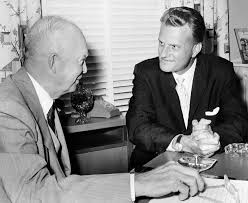
Graham operated a variety of media and publishing outlets. According to his staff, more than 3.2 million people have responded to the invitation at Billy Graham Crusades to “accept Jesus Christ as their personal savior”. Graham’s evangelism was appreciated by mainline Protestant and Roman Catholic denominations because he encouraged new converts to become members of these churches.
As of 2008, Graham’s estimated lifetime audience, including radio and television broadcasts, topped 2.2 billion. One special televised broadcast in 1996 alone may have reached a television audience of as many as 2.5 billion people worldwide. Because of his crusades, Graham preached the gospel to more people in person than anyone in the history of Christianity.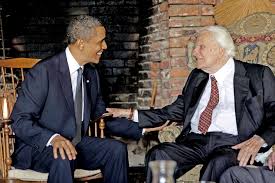
Graham was on Gallup’s list of most admired men and women a record 61 times. Grant Wacker writes that by the mid-1960s, he had become the “Great Legitimator”: “By then his presence conferred status on presidents, acceptability on wars, shame on racial prejudice, desirability on decency, dishonor on indecency, and prestige on civic events”.
The separation of church and state.
 After his close relationships with Lyndon B. Johnson and Richard Nixon, Graham tried to avoid explicit partisanship. Bailey says:
After his close relationships with Lyndon B. Johnson and Richard Nixon, Graham tried to avoid explicit partisanship. Bailey says:
- He declined to sign or endorse political statements, and he distanced himself from the Christian right … His early years of fierce opposition to communism gave way to plead for military disarmament and attention to AIDS, poverty and environmental threats.
 Graham was a registered member of the Democratic Party. In 1960, he was opposed to the candidacy of John F. Kennedy, fearing that Kennedy, as a Catholic, would be bound to follow the Pope. Graham worked “behind the scenes” to encourage influential Protestant ministers to speak out against Kennedy.
Graham was a registered member of the Democratic Party. In 1960, he was opposed to the candidacy of John F. Kennedy, fearing that Kennedy, as a Catholic, would be bound to follow the Pope. Graham worked “behind the scenes” to encourage influential Protestant ministers to speak out against Kennedy.
During the 1960 campaign, Graham met with a conference of Protestant ministers in Montreux, Switzerland, to discuss their mobilization of congregations to defeat Kennedy. According to the PBS Frontline program, God in America (2010), Episode 5, in September 1960, Graham organized a meeting of hundreds of Protestant ministers in Washington, D.C. for this purpose; the meeting was led by Norman Vincent Peale.
This was shortly before Kennedy’s speech in Houston, Texas on the separation of church and state; the speech was considered to be successful in meeting the concerns of many voters. After his election, however, Kennedy invited Graham to play golf in Palm Beach, Florida, after which Graham acknowledged Kennedy’s election as an opportunity for Catholics and Protestants to come closer together.
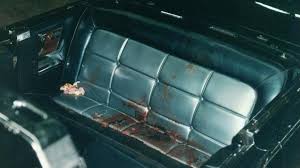 After they had discussed Jesus Christ at that meeting, the two remained in touch, meeting for the last time at a National Day of Prayer meeting in February 1963. In his autobiography, Graham claimed to have felt an “inner foreboding” in the week before Kennedy’s assassination, and to have tried to contact him to say, “Don’t go to Texas!”
After they had discussed Jesus Christ at that meeting, the two remained in touch, meeting for the last time at a National Day of Prayer meeting in February 1963. In his autobiography, Graham claimed to have felt an “inner foreboding” in the week before Kennedy’s assassination, and to have tried to contact him to say, “Don’t go to Texas!”
Graham opposed the large majority of abortions, but supported it as a legal option in a very narrow range of circumstances: rape, incest, and the life of the mother. The Billy Graham Evangelistic Association states that “Life is sacred, and we must seek to protect all human life: the unborn, the child, the adult, and the aged.”
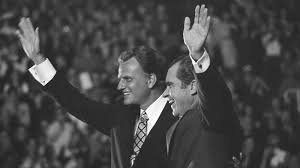 Graham leaned toward the Republicans during the presidency of Richard Nixon, whom he had met and befriended as Vice President under Dwight D. Eisenhower. He did not completely ally himself with the later religious right, saying that Jesus did not have a political party. He gave his support to various political candidates over the years.
Graham leaned toward the Republicans during the presidency of Richard Nixon, whom he had met and befriended as Vice President under Dwight D. Eisenhower. He did not completely ally himself with the later religious right, saying that Jesus did not have a political party. He gave his support to various political candidates over the years.
In 2007, Graham explained his refusal to join Jerry Falwell’s Moral Majority in 1979, saying: “I’m for morality, but morality goes beyond sex to human freedom and social justice. We as clergy know so very little to speak with authority on the Panama Canal or superiority of armaments. Evangelists cannot be closely identified with any particular party or person. We have to stand in the middle in order to preach to all people, right and left. I haven’t been faithful to my own advice in the past. I will be in the future.”
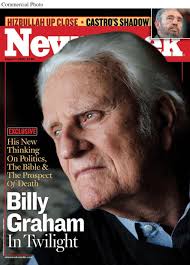 According to a 2006 Newsweek interview, “For Graham, politics is a secondary to the Gospel … When Newsweek asked Graham whether ministers – whether they think of themselves as evangelists, pastors or a bit of both – should spend time engaged with politics, he replied: ‘You know, I think in a way that has to be up to the individual as he feels led of the Lord. A lot of things that I commented on years ago would not have been of the Lord, I’m sure, but I think you have some – like communism, or segregation, on which I think you have a responsibility to speak out.”
According to a 2006 Newsweek interview, “For Graham, politics is a secondary to the Gospel … When Newsweek asked Graham whether ministers – whether they think of themselves as evangelists, pastors or a bit of both – should spend time engaged with politics, he replied: ‘You know, I think in a way that has to be up to the individual as he feels led of the Lord. A lot of things that I commented on years ago would not have been of the Lord, I’m sure, but I think you have some – like communism, or segregation, on which I think you have a responsibility to speak out.”
In 2012, Graham endorsed the Republican presidential candidate, Mitt Romney. Shortly after, apparently in order to accommodate Romney, who is a Mormon, references to Mormonism as a religious cult (“A cult is any group which teaches doctrines or beliefs that deviate from the biblical message of the Christian faith.”) were removed from Graham’s website.
Observers have questioned whether the support of Republican and religious right politics on issues such as same-sex marriage coming from Graham – who stopped speaking in public or to reporters – in fact reflects the views of his son, Franklin, head of the BGEA. Franklin denied this, and said that he would continue to act as his father’s spokesperson rather than allowing press conferences.
Personal audience with sitting U.S. presidents.
 Graham had a personal audience with many sitting US presidents, from Harry S. Truman to Barack Obama – 12 consecutive presidents. After meeting with Truman in 1950, Graham told the press he had urged the president to counter communism in North Korea. Truman disliked him and did not speak with him for years after that meeting. Later he always treated his conversations with presidents as confidential.
Graham had a personal audience with many sitting US presidents, from Harry S. Truman to Barack Obama – 12 consecutive presidents. After meeting with Truman in 1950, Graham told the press he had urged the president to counter communism in North Korea. Truman disliked him and did not speak with him for years after that meeting. Later he always treated his conversations with presidents as confidential.
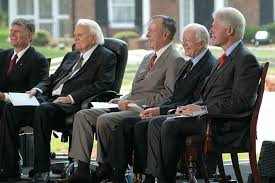 Truman was not fond of Graham. He wrote about Graham in his 1974 autobiography Plain Speaking, “But now we’ve got just this one evangelist, this Billy Graham, and he’s gone off the beam. He’s…well, I hadn’t ought to say this, but he’s one of those counterfeits I was telling you about. He claims he’s a friend of all the presidents, but he was never a friend of mine when I was President. I just don’t go for people like that. All he’s interested in is getting his name in the paper.”
Truman was not fond of Graham. He wrote about Graham in his 1974 autobiography Plain Speaking, “But now we’ve got just this one evangelist, this Billy Graham, and he’s gone off the beam. He’s…well, I hadn’t ought to say this, but he’s one of those counterfeits I was telling you about. He claims he’s a friend of all the presidents, but he was never a friend of mine when I was President. I just don’t go for people like that. All he’s interested in is getting his name in the paper.”
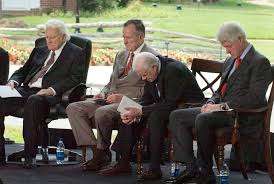 Graham became a regular visitor during the tenure of Dwight D. Eisenhower. He purportedly urged him to intervene with federal troops in the case of the Little Rock Nine to gain admission of black students to public schools. House Speaker Sam Rayburn convinced Congress to allow Graham to conduct the first religious service on the steps of the Capitol building in 1952. Eisenhower asked for Graham while on his deathbed.
Graham became a regular visitor during the tenure of Dwight D. Eisenhower. He purportedly urged him to intervene with federal troops in the case of the Little Rock Nine to gain admission of black students to public schools. House Speaker Sam Rayburn convinced Congress to allow Graham to conduct the first religious service on the steps of the Capitol building in 1952. Eisenhower asked for Graham while on his deathbed.
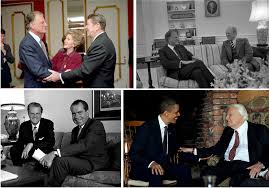 Graham met and would become a close friend of Vice President Richard Nixon, and supported Nixon, a Quaker, for the 1960 presidential election. He convened an August strategy session of evangelical leaders in Montreaux, Switzerland, to plan how best to oppose Nixon’s Roman Catholic opponent, Senator John F. Kennedy.
Graham met and would become a close friend of Vice President Richard Nixon, and supported Nixon, a Quaker, for the 1960 presidential election. He convened an August strategy session of evangelical leaders in Montreaux, Switzerland, to plan how best to oppose Nixon’s Roman Catholic opponent, Senator John F. Kennedy.
Though a registered Democrat, Graham also maintained firm support of aggression against the foreign threat of Communism and strongly sympathized with Nixon’s views regarding American foreign policy. Thus, he was more sympathetic to Republican administrations.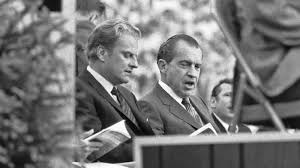
On December 16, 1963, U.S. President Lyndon B. Johnson, who was impressed by the way Graham had praised the work of his great-grandfather, the Rev. George Washington Baines, invited Graham to the White House to give him spiritual counseling.
After this visit, Johnson would frequently call on Graham for more spiritual counseling as well as companionship. As Graham recalled to his biographer Frady, “I almost used the White House as a hotel when Johnson was President. He was always trying to keep me there. He just never wanted me to leave.”
In contrast with his more limited access with Truman, Eisenhower and Kennedy, Graham would not only visit the White House private quarters but would also at times kneel at Johnson’s bedside and then pray with him whenever the President requested him to do so. Graham once recalled “I have never had many people do that.”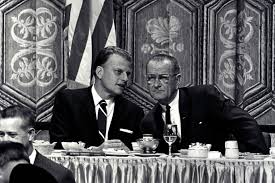
In addition to his White House visits, Graham would visit Johnson at Camp David and occasionally met with the President when he retreated to his private ranch in Stonewall, Texas. Johnson was also the first sitting President to attend one of Graham’s crusades, which took place in Houston, Texas, in 1965.
During the 1964 United States presidential election, supporters of Republican nominee Barry Goldwater sent an estimated 2 million telegrams to Graham’s hometown of Montreat, North Carolina, and sought the preacher’s endorsement. Supportive of Johnson’s domestic policies, and hoping to preserve his friendship with the President, Graham resisted pressure to endorse Goldwater and stayed neutral in the election.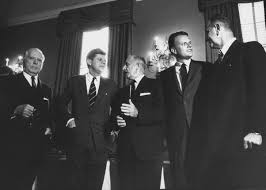
Following Johnson’s election victory, Graham’s role as the main White House pastor was solidified. At one point, Johnson even considered making Graham a member of his cabinet and grooming him to be his successor, though Graham insisted he had no political ambitions and wished to remain a preacher. Graham’s biographer David Aikman acknowledged that the preacher was closer to Johnson than any other President he had ever known.
He spent the last night of Johnson’s presidency in the White House, and he stayed for the first night of Nixon’s. After Nixon’s victorious 1968 presidential campaign, Graham became an adviser, regularly visiting the White House and leading the president’s private worship services. In a meeting they had with Golda Meir, Nixon offered Graham the ambassadorship to Israel, but he refused.
In 1970, Nixon appeared at a Graham revival in East Tennessee, which they thought safe politically. It drew one of the largest crowds in Tennessee and protesters against the Vietnam War. Nixon was the first president to give a speech from an evangelist’s platform. Their friendship became strained in 1973 when Graham rebuked Nixon for his post-Watergate behavior and the profanity heard on the Watergate tapes. They eventually reconciled after Nixon’s resignation.
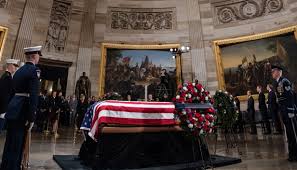 Graham officiated at one presidential burial and one presidential funeral. He presided over the graveside services of President Lyndon B. Johnson in 1973 and took part in eulogizing the former president. Graham officiated at the funeral services of former First Lady Pat Nixon in 1993, and the death and state funeral of Richard Nixon in 1994.
Graham officiated at one presidential burial and one presidential funeral. He presided over the graveside services of President Lyndon B. Johnson in 1973 and took part in eulogizing the former president. Graham officiated at the funeral services of former First Lady Pat Nixon in 1993, and the death and state funeral of Richard Nixon in 1994.
During the Monica Lewinsky scandal, Graham asserted that he believed President Bill Clinton to be “a spiritual person”. He was unable to attend the state funeral of Ronald Reagan on June 11, 2004, as he was recovering from hip replacement surgery. This was mentioned by George W. Bush in his eulogy.
On April 25, 2010, President Barack Obama visited Graham at his home in Montreat, North Carolina, where they “had a private prayer”.
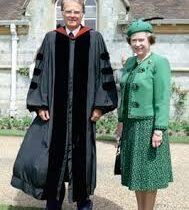 Relationship with Queen Elizabeth II
Relationship with Queen Elizabeth II
Graham had a friendly relationship with Queen Elizabeth II and was frequently invited by the Royal Family to special events. They first met in 1955 and Graham preached at Windsor Chapel at the Queen’s invitation during the following year. Their friendly relationship may have been because they shared a traditional approach to the practical aspects of the Christian faith.
Graham’s views on Foreign Policy
 Graham was outspoken against communism and supported the American Cold War policy, including the Vietnam War. In a 1999 speech, Graham discussed his relationship with the late North Korean leader Kim Il-sung, praising him as a “different kind of communist” and “one of the great fighters for freedom in his country against the Japanese.”
Graham was outspoken against communism and supported the American Cold War policy, including the Vietnam War. In a 1999 speech, Graham discussed his relationship with the late North Korean leader Kim Il-sung, praising him as a “different kind of communist” and “one of the great fighters for freedom in his country against the Japanese.”
Graham went on to note that although he had never met Kim’s son and former North Korean leader Kim Jong-il, he had “exchanged gifts with him.”
In 1982, Graham preached in the Soviet Union and attended a wreath-laying ceremony to honor the war dead of World War II, when the Soviets were American allies in the fight against Nazism. He voiced fear of a second holocaust, not against Jews, but “a nuclear holocaust” and advised that “our greatest contribution to world peace is to live with Christ every day.”
Billy Graham’s final mortal stages.
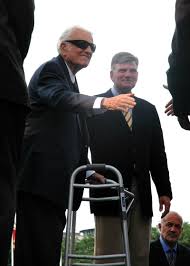 Graham said that his planned retirement was a result of his failing health; he had suffered from hydrocephalus from 1992 on. In August 2005, Graham appeared at the groundbreaking for his library in Charlotte, North Carolina. Then 86, he used a walker during the ceremony. On July 9, 2006, he spoke at the Metro Maryland Franklin Graham Festival, held in Baltimore, Maryland, at Oriole Park at Camden Yards.
Graham said that his planned retirement was a result of his failing health; he had suffered from hydrocephalus from 1992 on. In August 2005, Graham appeared at the groundbreaking for his library in Charlotte, North Carolina. Then 86, he used a walker during the ceremony. On July 9, 2006, he spoke at the Metro Maryland Franklin Graham Festival, held in Baltimore, Maryland, at Oriole Park at Camden Yards.
In April 2010, Graham was 91 and experiencing substantial vision, hearing and balance loss when he made a rare public appearance at the re-dedication of the renovated Billy Graham Library.
There had been controversy over Graham’s proposed burial place; he announced in June 2007 that he and his wife would be buried alongside each other at the Billy Graham Library in his hometown of Charlotte. Graham’s younger son Ned had argued with older son Franklin about whether burial at a library would be appropriate.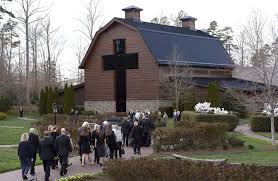
Ruth Graham had said that she wanted to be buried not in Charlotte but in the mountains at the Billy Graham Training Center at The Cove near Asheville, North Carolina, where she had lived for many years; Ned supported his mother’s choice.
Novelist Patricia Cornwell, a family friend, also opposed burial at the library, calling it a tourist attraction. Franklin wanted his parents to be buried at the library site. At the time of Ruth Graham’s death, it was announced that they would be buried at the library site.
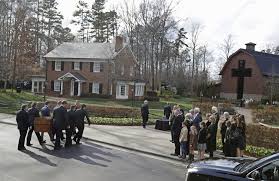 Graham died of natural causes on February 21, 2018, at his home in Montreat, North Carolina, at the age of 99.
Graham died of natural causes on February 21, 2018, at his home in Montreat, North Carolina, at the age of 99.
On February 28 and March 1, 2018, Graham became the fourth private citizen in United States history to lie in honor at the United States Capitol rotunda in Washington, D.C. He is the first religious leader to be so honored. At the ceremony, Senate Majority Leader Mitch McConnell and Speaker of the House Paul Ryan called Graham “America’s pastor”.
 President Donald Trump said Graham was “an ambassador for Christ”. In addition, Televangelist Jim Bakker paid respect to Graham, stating he was the greatest preacher since Jesus. He also said that Graham visited him in prison.
President Donald Trump said Graham was “an ambassador for Christ”. In addition, Televangelist Jim Bakker paid respect to Graham, stating he was the greatest preacher since Jesus. He also said that Graham visited him in prison.
A private funeral service was held on March 2, 2018. Graham was buried beside his wife at the foot of the cross-shaped brick walkway in the Prayer Garden on the northeast side of the Billy Graham Library. Graham’s pine plywood casket, handcrafted in 2006 by convicted murderers at the Louisiana State Penitentiary, is topped with a wooden cross nailed to it by the prisoners.
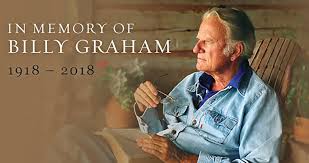
Please Leave All Comments in the Comment Box Below ↓




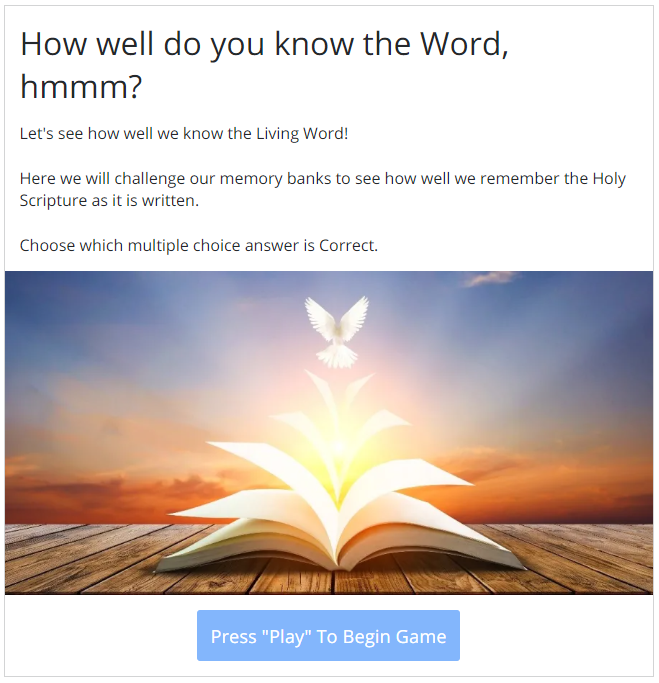




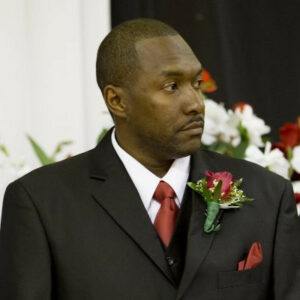




This is very interesting, because I really loved Billy Graham,
It’s fascinating to watch his son Franklin now, because he reminds me of him so much. This post offers a very detailed portrait of his life with events in it that I was never aware of.
I very fondly remember his televised crusades from when I was really young. Even at that age, I just couldn’t not listen to the man. He had something, some very special type of charisma, that could capture anyone’s heart, as he spoke directly to their soul.
Thanks for sharing this wonderful account of his life!
Mark
Hello Mark,
Thank you for your interest in reading and commenting on this article about William Franklin Graham Jr. I must agree, as a child, watching Him was addictive, he actually held my attention with the way he spoke and his words were so captivating.
Thank you for considering this a wonderful account of his life, and again for reading and commenting on this article.
I Hope For Many Blessings For You My Friend!
Hello there,
Thanks for this article about such a great man of God. He is one of the greatest evangelists the world has ever had. He is a great mentor and spirit-filled man of God. I think it will take a long time before the world can produce such a man who is devoted to doing the work of God again.
Hi,
Thank you for reading and commenting about this article and how wonderful of a man William Franklin Graham Jr. really is and was.
GOD Bless!
Hello Dear,
A big thanks to you for sharing this beautiful article on William Franklin Graham Jr. I must say that this is really an insightful, inspiring, motivating history and story he’s got. He had really impacted in so many lives and also helped to aslo shape the world view of a huge number of people who came from different backgrounds, leading them to find a relationship between the bible and contemporary secular viewpoints.
William Franklin Graham Jr is a great mentor to so many.
Hi,
Thank you for reading and commenting on this article.
It most definitely pleases me to learn that this article has really impacted you a lot. Thank you again for utilizing a portion of your time for the reading and commenting on this article.
I Wish You Lots of Blessings on Your Journey!
Hello there,
This is an amazing article that you have got here. Indeed Graham was a man that shook this world. Sometimes I wished I was born in his time were the sound of true revival was alert. I would watch some of his videos and cry.
How can a man walk with God that much to be used by him?
Is it his anointing and authority that triggers the why?
He is a Hero!
Hi,
Thank you so much for utilizing a portion of your time for the reading, accurately commenting on this article and considering it an amazing article about William Franklin Graham Jr.
Blessings and Cheers To You My Friend!
Quite an amazing and Intriguing tale on William Franklin Graham,
William is indeed a great preacher, a giver, a believer and a good example of a true disciple of Christ. He’s over the years in the quest for serving God delightfully with a lot of good deeds that other preachers find difficult to do. He’s a true definition of a Christian and I hope we follow this footsteps.
Thanks for the review!
Thank you for reading and commenting on this article.
You are welcome for its creation.
Wishing you much success ahead!
Hi Jerry –
What a great exposé Of Billy Graham. He was one of the greatest spiritual leaders of all time. We could certainly use another one like him today. We need someone who can encourage unity and hope to our nation; a non political figure of course.
Thanks so much for sharing this!
Hello,
I also agree that we could certainly use another Spiritual Leader like William Franklin Graham Jr. He most definitely is truly missed.
Thank you so much for utilizing a portion of your time to read and comment on this post. I really appreciate your remarks.
Warm Regards To You My Friend!